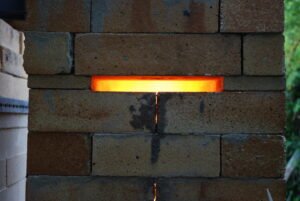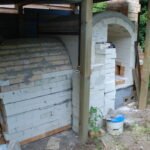
I currently have an LPG gas kiln and two wood kilns, which are of different designs. Living in East Anglia, where there are not that many trees, finding suitable wood for fuel is a constant struggle. Partly due to this, but also because I think that we should make as much use as possible of limited resources, my woodfiring philosophy is to create rich and varied surfaces using as little wood, and emitting as little smoke as possible. That means relatively efficient kilns, with clean burning design and relatively short firings. I generally fire for between 20 and 32 hours, depending on the kiln I use and the work inside.
The difficulty facing me is creating rich surfaces with less time at top temperature and less wood burnt, and therefore less ash being deposited on the pots. The answer is to think very carefully about what it put into the kiln. A refractory clay will need a long firing to develop a rich wood fired surface, but if it is covered with a slip or, better yet, a glaze that is particularly reactive, it will attract more ash and perform well in shorter times. All of my pots are made using slips, embedded rocks and glazes that will emphasise the reactions that occur within wood kilns, using material knowledge to create rich, complex surfaces rather than time (or brute force).

To fire my kilns, I use wood from trees that have grown locally and either fallen or cut by tree surgeons. I often get the pieces of the tree, such as branch junctions, that are difficult to split and so unwanted by firewood producers. As a result, my firewood is all different lengths, which influences the type of firebox I can use.

The first kiln is a sprung arch chamber with an extended catenary arch firebox leading directly into it, with a small step up into the chamber. Half of the catenary arch space is firebox and half available to pack pots. Between the two chambers is a sidestoke port. It turned out I did not need to use this to even up the temperature in the two sections of the kiln. Instead I use it mid firing, to build up an ember bed and get more direct ash into the back chamber of the kiln. I get some of my best pots either side of this space despite relatively little sidestoking.
The second kiln is simply an extended (slightly stretched out) catenary arch, that sits up on a rectangular section of brick. I wanted a simple, easy to build design that doesn't use as many bricks as if it had a separate firebox. I also wanted to house the firebox within the chamber itself, to maximise the effects of the ash produced. This is a very different design from any of my previous kilns, and is taking a bit of time to get used to, though the results so far are very promising.


My kilns are situated next to open fields, but I still try to produce as little smoke as possible during my firings. Partly to keep a low profile, but mainly to reduce the emission of pollutants. A reduction atmosphere needs to be maintained in the chambers once 1000C has passed, though it's not only easy but common practice to overdo this. When the kiln is firing well there is a distinct lack of drama; no black smoke or flames shooting out of the chimney, firebox doors or gaps in the bricks. The level of reduction can be monitored by the presence of a flame in the 'blowhole' at the top of the arch, and a flame in the chimney. Any more than this is just a waste of wood and production of pollution.
Firing with as little smoke as possible is enabled by certain kiln design features and also stoking style. Both the chimneys on my kilns are a little taller than absolutely needed, meaning I can use passive dampers to reduce the air flow through the kiln. A shelf sliding into the chimney is an active damper. If a brick is removed from the lower section of the chimney, it also reduces air flow through the chamber by allowing air to enter direct into the chimney. This is a passive damper. The advantage of passive dampers is they allow oxygenated air into a hot chimney, which burns the carbon and carbon monoxide in the exit flue, enabling a clean burn at the top of the chimney.
The rate of stoking is critical. I fire with a constant stoking of one or two pieces of wood at a time. If the firebox is overloaded, the amount of external flame and smoke produced certainly looks spectacular, but it's negating the positives of using wood as a sustainable fuel.

